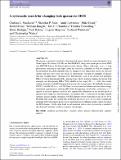A systematic search for changing-look quasars in SDSS
Abstract
We present a systematic search for changing-look quasars based on repeat photometry from Sloan Digital Sky Survey (SDSS) and Pan-STARRS1, along with repeat spectra from SDSS and SDSS-III Baryon Oscillation Spectroscopic Survey. Objects with large, |Δg| > 1 mag photometric variations in their light curves are selected as candidates to look for changes in broad emission line (BEL) features. Out of a sample of 1011 objects that satisfy our selection criteria and have more than one epoch of spectroscopy, we find 10 examples of quasars that have variable and/or ‘changing-look’ BEL features. Four of our objects have emerging BELs, five have disappearing BELs, and one object shows tentative evidence for having both emerging and disappearing BELs. With redshifts in the range 0.20 <z <0.63, this sample includes the highest redshift changing-look quasars discovered to date. We highlight the quasar J102152.34+464515.6 at z = 0.204. Here, not only have the Balmer emission lines strongly diminished in prominence, including Hβ all but disappearing, but the blue continuum fν∝ν1/3 typical of an active galactic nuclei is also significantly diminished in the second epoch of spectroscopy. Using our selection criteria, we estimate that >15 per cent of strongly variable luminous quasars display changing-look BEL features on rest-frame time-scales of 8 to 10 yr. Plausible time-scales for variable dust extinction are factors of 2–10 too long to explain the dimming and brightening in these sources, and simple dust reddening models cannot reproduce the BEL changes. On the other hand, an advancement such as disc reprocessing is needed if the observed variations are due to accretion rate changes.
Citation
MacLeod , C L , Ross , N P , Lawrence , A , Goad , M , Horne , K , Burgett , W , Chambers , K C , Flewelling , H , Hodapp , K , Kaiser , N , Magnier , E , Wainscoat , R & Waters , C 2016 , ' A systematic search for changing-look quasars in SDSS ' , Monthly Notices of the Royal Astronomical Society , vol. 457 , no. 1 , pp. 389-404 . https://doi.org/10.1093/mnras/stv2997
Publication
Monthly Notices of the Royal Astronomical Society
Status
Peer reviewed
ISSN
0035-8711Type
Journal article
Description
CLM acknowledges support from the STFC Consolidated Grant (Ref. St/M001229/1). NPR acknowledges support from the STFC and the Ernest Rutherford Fellowship scheme. KH acknowledges support from STFC grant ST/M001296/1. Funding for the SDSS and SDSS-II has been provided by the Alfred P. Sloan Foundation, the Participating Institutions, the National Science Foundation, the US Department of Energy, the National Aeronautics and Space Administration, the Japanese Monbukagakusho, the Max Planck Society, and the Higher Education Funding Council for England.Collections
Items in the St Andrews Research Repository are protected by copyright, with all rights reserved, unless otherwise indicated.

